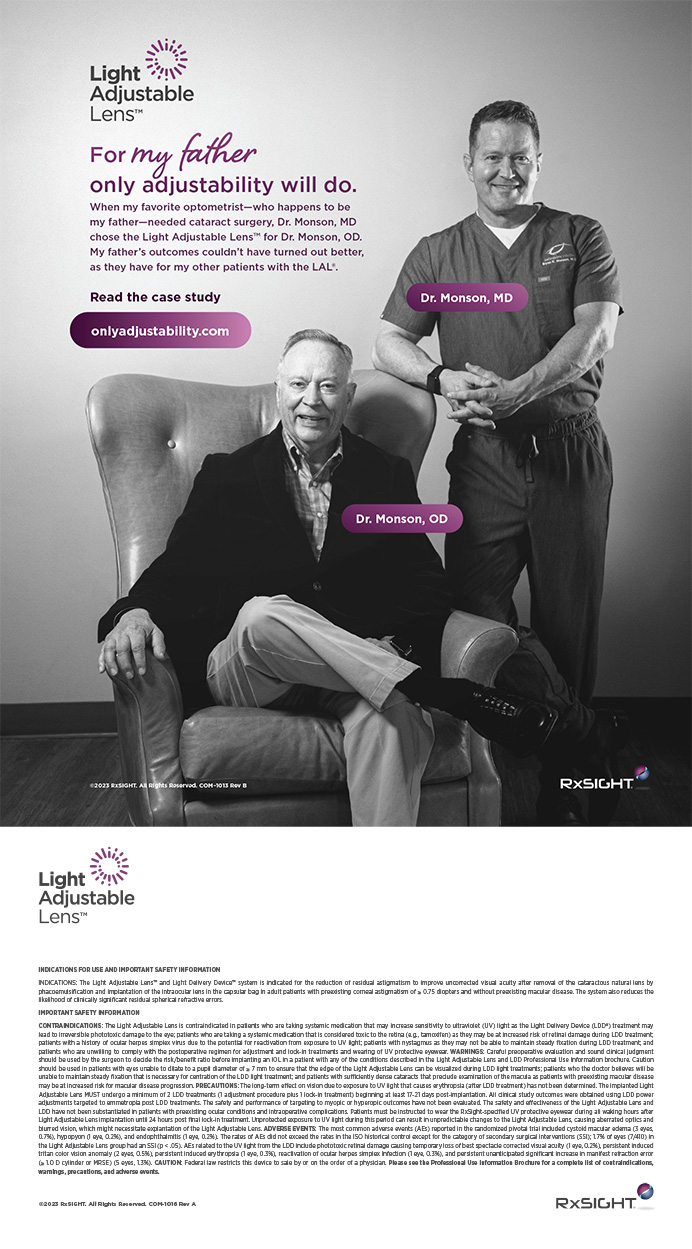Significant zonular dehiscence or weakness poses a challenge during cataract surgery. The ophthalmologist may not detect instability of a dense cataract until the initial steps of cataract surgery, particularly creation of the capsulorhexis, when he or she may notice unusual movement of the lens or wrinkling of the capsule. It is therefore important to maintain a high level of suspicion when operating on posttraumatic and postvitrectomy eyes so that the surgeon can take appropriate steps if need be. At other times, such as in this case, the lens has shifted significantly, and pupillary dilation may even reveal an irregular equatorial region of the cataract, with regions where the zonules are visibly absent.
PREOPERATIVE EXAMINATION AND PREPARATION
The patient initially presented with a complaint of trauma to his left eye 16 years earlier. His visual acuity had deteriorated after a subsequent pars plana vitrectomy, and during the current examination, I found it difficult to view the fundus. B-scan ultrasound showed an attached retina and clear vitreous. After a discussion with the patient, my plan was to reinforce the capsular support and implant a lens in the capsular bag with scleral suturing. My backup plan was iris fixation of a three-piece IOL or an ACIOL.
SURGERY
Visualization is important during the creation of the capsulorhexis but can be difficult when the cataract is white or dense. Because of the significant dislocation of the lens and large zonular defect, I instilled VisionBlue (DORC International BV) in the anterior chamber under a dispersive viscoelastic (Viscoat; Alcon Laboratories, Inc.) and painted the intraocular dye onto the central portion of the capsule. This measure keeps the dye from passing around the equator of the dislocated lens and into the vitreous, which will turn blue and compromise the red reflex for the remainder of the case.
After staining the capsule, I carefully centered the capsular opening on the midpoint of the decentered lens. I initiated the tear with a cystotome for better control and carefully completed the capsulorhexis (Figure). An area of fibrosis made this step more difficult in one area, and the opening was a little smaller than I wanted. I keep an interchangeable set of microforceps and microscissors (Duet Bimanual System; MicroSurgical Technology) on hand so that the capsulotomy can be enlarged if necessary. A microscissors was used in this case to initiate a small radial tear so that the capsular opening could be expanded.
I inflated the equatorial capsular bag in the area of the zonular defect. Next, I introduced an Ahmed Capsular Tension Segment (CTS; Morcher GmbH, distributed in the United States by FCI Ophthalmics, Inc.) by gently nudging the element into the capsular fornix with a Kuglen-style second instrument. I positioned the eyelet anterior to the anterior capsular leaflet. Then, I introduced an iris hook (Synergetics, Inc.) into a previously placed paracentesis and used the instrument to hook and support the CTS through the eyelet. I performed nuclear disassembly via my usual combination of vertical and horizontal chopping techniques. I used a silicone I/A tip (CapsuleGuard; Bausch + Lomb) to make the removal of sticky cortex as gentle as possible in the setting of a fibrotic capsule. I also facilitated the removal of small nuclear chips and fragments by “mashing” them into the soft silicone port with a chopper.
I inflated the capsular bag with viscoelastic and used an intraocular microforceps to help me withdraw the iris hook. I made a conjunctival peritomy in the area of the dehiscence and created a 2-mm partial-thickness groove in the sclera 3 mm posterior to the limbus. Using a double-armed 6–0 Prolene suture on a long curved needle (Ethicon, Inc.), I sutured the CTS to the sclera with an ab externo approach and used a 26-gauge needle as a guide through the scleral groove. It is important to be sure the guide and suture needle are appropriately sized to allow easy docking. I inserted a preloaded capsular tension ring (EyeJet; Morcher GmbH) in the capsular bag for additional centration and support.
After the capsule stabilized, I implanted a single-piece hydrophobic acrylic IOL (SN60WF; Alcon Laboratories, Inc.). I chose the lens for the gentle way it unfolds in the eye. I tied the suture with locking knots and buried the knot by rotating it into the eye. The conjunctiva was closed with 7–0 Vicryl interrupted sutures (Ethicon, Inc.) with the knots buried. At the end of the surgery, the IOL was well centered with strong support, and the result was successful.
POSTOPERATIVE COURSE
When a case requires copious amounts of a dispersive viscoelastic, I prescribe oral acetazolamide (500-mg sequel) to prevent a postoperative elevation in pressure. I also select a stronger topical steroid than usual (difluprednate ophthalmic emulsion 0.05%; Durezol; Alcon Laboratories, Inc.) along with a topical nonsteroidal antiinflammatory drug (bromfenac ophthalmic solution 0.09%; Bromday; Bausch + Lomb). Unfortunately, a macular scar through the fovea limited this patient's postoperative vision, although his peripheral vision improved, as did the view of the posterior pole.
Cathleen M. McCabe, MD, practices at the Eye Associates in Bradenton and Sarasota, Florida. She is a speaker and investigator for Alcon Laboratories, Inc., and she is a speaker for and consultant to Bausch + Lomb. Dr. McCabe may be reached at (941) 792-2020; cmccabe13@hotmail.com.


